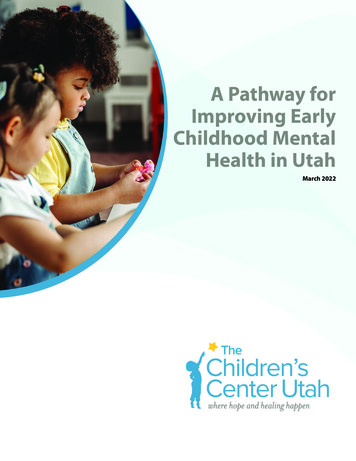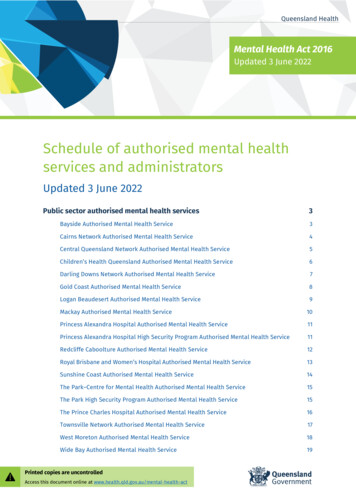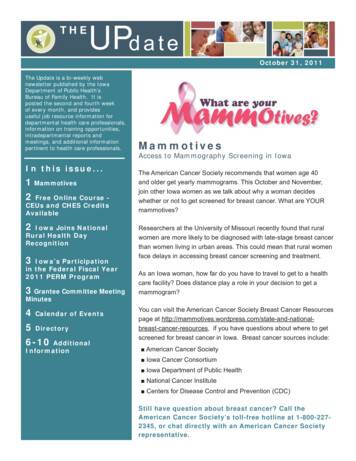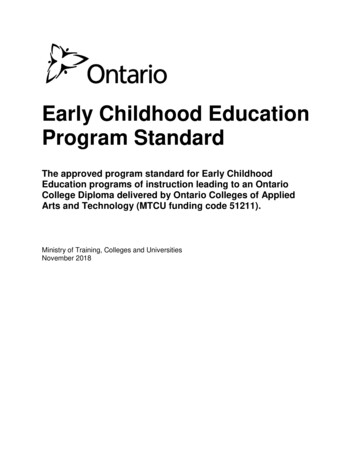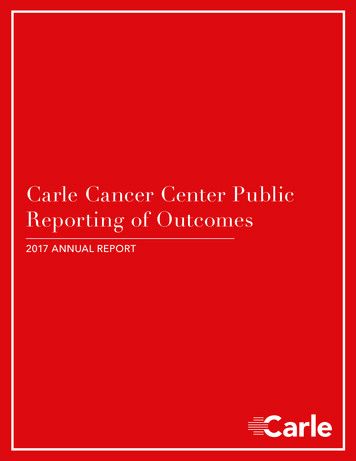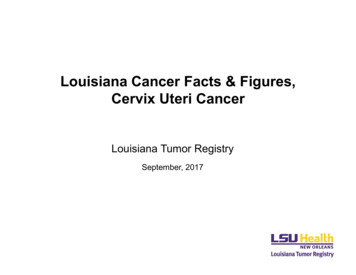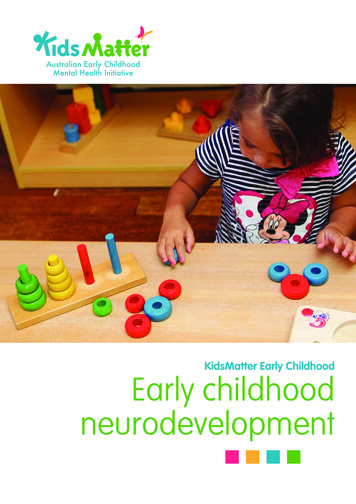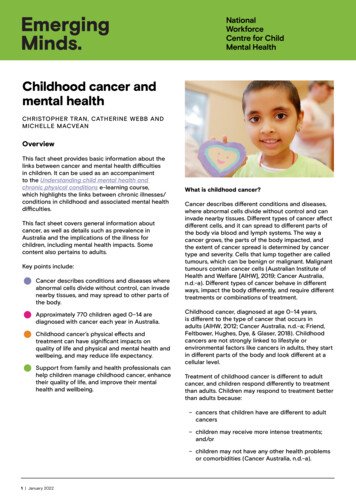
Transcription
NationalWorkforceCentre for ChildMental HealthChildhood cancer andmental healthCHRISTOPHER TRAN, CATHERINE WEBB ANDMICHELLE MACVEANOverviewThis fact sheet provides basic information about thelinks between cancer and mental health difficultiesin children. It can be used as an accompanimentto the Understanding child mental health andchronic physical conditions e-learning course,which highlights the links between chronic illnesses/conditions in childhood and associated mental healthdifficulties.This fact sheet covers general information aboutcancer, as well as details such as prevalence inAustralia and the implications of the illness forchildren, including mental health impacts. Somecontent also pertains to adults. Key points include:Cancer describes conditions and diseases whereabnormal cells divide without control, can invadenearby tissues, and may spread to other parts ofthe body.Approximately 770 children aged 0–14 arediagnosed with cancer each year in Australia.Childhood cancer’s physical effects andtreatment can have significant impacts onquality of life and physical and mental health andwellbeing, and may reduce life expectancy.Support from family and health professionals canhelp children manage childhood cancer, enhancetheir quality of life, and improve their mentalhealth and wellbeing.What is childhood cancer?Cancer describes different conditions and diseases,where abnormal cells divide without control and caninvade nearby tissues. Different types of cancer affectdifferent cells, and it can spread to different parts ofthe body via blood and lymph systems. The way acancer grows, the parts of the body impacted, andthe extent of cancer spread is determined by cancertype and severity. Cells that lump together are calledtumours, which can be benign or malignant. Malignanttumours contain cancer cells (Australian Institute ofHealth and Welfare [AIHW], 2019; Cancer Australia,n.d.-a). Different types of cancer behave in differentways, impact the body differently, and require differenttreatments or combinations of treatment.Childhood cancer, diagnosed at age 0–14 years,is different to the type of cancer that occurs inadults (AIHW, 2012; Cancer Australia, n.d.-a; Friend,Feltbower, Hughes, Dye, & Glaser, 2018). Childhoodcancers are not strongly linked to lifestyle orenvironmental factors like cancers in adults, they startin different parts of the body and look different at acellular level.Treatment of childhood cancer is different to adultcancer, and children respond differently to treatmentthan adults. Children may respond to treatment betterthan adults because:– cancers that children have are different to adultcancers– children may receive more intense treatments;and/or– children may not have any other health problemsor comorbidities (Cancer Australia, n.d.-a).1 January 2022
What is the prevalence of childhood cancer inAustralia?During 2011–15, 35% of all childhood cancer caseswere leukaemias – types of cancer that affect theblood and blood-producing tissues in the body(AIHW, 2019) – making them the most common typeof cancer diagnosed in Australian children. Tumoursof the central nervous systems (mainly brain tumours)are the second most common at 14% of all diagnosesin children, followed by lymphomas at 13% ofdiagnoses (AIHW, 2020).Childhood cancer in 2011–15 was more prevalent inboys (55%) than girls (45%) (AIHW, 2020). Prevalenceof childhood cancer was almost twice as high inchildren aged 0–4 years (23 per 100,000 children)than children aged 5–9 years (12 per 100,000), and1.6 times that of children aged 10–14 (14 per 100,000)(AIHW, 2020).Three common types of cancer treatment arechemotherapy, radiation therapy and surgery.Although cancer treatment is more likely to beeffective in children than adults, children are morelikely to have side effects from certain types oftreatment as their bodies are still growing (AmericanCancer Society, 2019). Some side effects may subsideor even go away, but many will require ongoingvisits to specialists, lifestyle changes, or even furthertreatment for the side effects. Cancer treatments mayimpact the following:– brain development– sensory systems– thyroid gland– muscles and bones– cardiovascular system– lungsChildhood cancer in Australia– teethAccording to the Australian Childhood CancerRegistry, it is estimated that about 770 childrenaged 0–14 are diagnosed with cancer each yearin Australia (Cancer Council Queensland, 2017).– overall growth; and/orWhat are the implications of childhood cancer forthe child?Cancer symptoms in children can appear to be similarto many other medical conditions and may include:– bruising– lumps or swelling– paleness– tiredness or lethargy– persistent pain– movement difficulties– fever or illness that does not resolve– headaches– nausea– vomiting– changes to vision– balance problems, and/or– unexplained weight loss (Cancer Australia, n.d.-a).2 January 2022– sexual development and fertility.Cancer treatment sometimes also presents a risk fordevelopment of a second cancer (American CancerSociety, 2017; Cancer Council, n.d.-b). Cancer and itstreatment may also impact school attendance andacademic achievement (Tsimicalis, Genest & Stevens,2018), social interactions (Cancer Institute NSW,n.d.) and participation in activities (Alizadeh Zarei,Mohammadi, Mehreban, Ansari Damavandi, & Amini ,2017).Some children with cancer have reduced lifeexpectancies. Cancer is reported to be the secondleading cause of death in children aged 0–14 years,after injury-related deaths. During 2015–17, therewere 92 cancer-related deaths a year among childrenaged 0–14 years, at a rate of two deaths per 100,000(AIHW, 2020). In 2015–17, the most common cancersthat caused death among children were brain cancer,acute myeloid leukaemia, and acute lymphoblasticleukaemia (AIHW, 2020).
What are the mental health impacts of childhoodcancer?– anxietyChildren diagnosed with cancer experience a range ofmental health impacts. The incidence and intensity ofmental health impacts can also be influenced by theage of the child, their parents’ mental health, and thetype of support the child receives (Friend et al., 2018).– post-traumatic stress disorderResearch has consistently found that immediatelyafter the diagnosis of cancer and in the months afterthe diagnosis, children experience increased distress,reduced quality of life, and psychosocial functioningchallenges (Kazak et al., 2015). These challenges mayimpact on many aspects of life, including relationships,school and work (American Cancer Society, 2017).Some post-treatment concerns that may impactimmediate or long-term emotional wellbeing include:– antisocial behaviour– schizophrenia– poor body image– difficulties fulfilling expected roles– mood swings– oppositional defiant disorder– drug and alcohol misuse– suicidal ideation; and– unmet emotional and coping needs (CancerAustralia, n.d.-b; Friend et al., 2018).– dealing with physical changes resulting from thecancer or treatmentWhat impact does childhood cancer have onfamilies?– ongoing tests and check-upsFollowing the diagnosis of a child with cancer,families may experience a time of increased distress,poorer quality of life, and difficulties in psychosocialfunctioning (Kazak et al., 2015). Many challengesand changes occur in the day-to-day life of thefamily, however there is also evidence that parentsmay eventually develop good coping and resilience(Kearney, Salley & Muriel, 2015).– changes to diet and activity participation– concerns the cancer may return, or new healthproblems developing– feelings of resentment for having had cancer, orhaving to go through treatment when others donot– concerns about being treated differently ordiscriminated against by others; and– concerns about dating, marrying, and havinga family later in life (American Cancer Society,2017).Many survivors of childhood cancer thrive posttreatment. Over time, some childhood cancersurvivors find meaning in their experience whichfacilitates priority setting and establishing strongpersonal values. For others, it remains difficultadjusting to life after cancer (American CancerSociety, 2017). It is recommended that symptoms ofmental health impact are identified early, and supportis accessed. Psychologists and social workers cansupport children early in treatment using effectiveinterventions such as mindful-based stress reductionand cognitive-behavioural therapy (Kunin-Batson etal., 2016).Some mental health impacts appear at least five yearsafter the diagnosis, and can be present over 30 yearsafter treatment has ceased. These can include:– poor self-esteem– depression3 January 2022In addition to facing uncertainty about progressionof cancer, a cancer diagnosis may bring about newroles and responsibilities which caregivers may havehad little experience in and may involve practicalchallenges such as adjustments to work and/oradditional expenses (Taylor, Fradgley, Clinton-McHarg,Byrnes, & Paul, 2021; Teixeira, Applebaum, Bhatia,& Brandão, 2018). Caregivers may also experiencedistress, isolation and anxiety (Shokri, Tarjoman, Borji,& Solaimanizadeh, 2020; Taylor et al., 2021; Teixeira etal., 2018).Siblings of the diagnosed child may experiencemore depression, anxiety and worse relationshipswith peers, compared with siblings who do not havea chronically ill sibling (Erker, Yan, Zhang, Bingen,Flynn, & Panepinto, 2018). Siblings are affected acrossdifferent areas of their lives, including:– emotional and behavioural functioning– quality of life– relationships with family members– school attendance and performance and– health behaviours (Long et al., 2018).
ConclusionBrainchild FoundationCancer can have significant implications for children’soverall development and wellbeing, includingongoing mental health concerns. Early identificationof these concerns and access to professionalservices including allied health practitioners andsocial workers, offers the potential to alleviate thechallenges for children and their families. Furtherinformation about the impact of chronic conditions onmental health can be found within the Understandingchild mental health and chronic physical conditionse-learning course.Charity that supports children who are affected bybrain and spinal cord tumours, and their families.Youth Cancer ServicesProvides specialist, age-specific treatment andsupport for young people with cancer.Parenting Through CancerCommunity designed by CanTeen and Camp Qualityto connect parents affected by cancer, and providesupport and resources to help the family’s cancerjourney.Kids with Cancer Foundation AustraliaFoundation that supports children with cancer andtheir families with finances.Leukaemia FoundationFoundation that has resources and support servicesfor people with leukaemia and their families,occasionally providing accommodation near majorhospitals.Where can I go for further information on childhoodcancer?Cancer AustraliaAustralian government website with information aboutchildren’s cancer, including a list of places to getsupport.Consumer Involvement ToolkitCancer Australia’s toolkit helps people affected bycancer to engage with local health services andcommunity, cancer and research organisations.RedkiteProvides financial assistance, emotional support andeducational assistance to children with cancer andtheir families. It also has scholarships available forspecific educational goals.The support line 1800 REDKITE is open between 9amand 7pm Monday to Friday.Ronald McDonald House CharitiesCharity that provides programs including educationalsupport and accommodation near treatment centres.Cancer CouncilStarlight Children’s FoundationState- or territory-specific general information aboutcancer, including resources and support groups inlocal areas.Foundation that provides a range of programs tosupport the wellbeing of seriously ill children.The 13 11 20 support line is available between 9 amand 5 pm Monday to Friday, connecting families withexperienced cancer nurses or health professionals.Children’s Cancer FoundationFoundation that helps children with cancer accessworld-leading treatment and support. It also supportsfamilies throughout the treatment process.4 January 2022Kids’ Cancer ProjectIndependent national charity dedicated to supportingchildhood cancer research.
What are some other supports for children andfamilies?Beyond BlueBeyond Blue provides information and support tohelp everyone in Australia to achieve their bestpossible mental health. The service supports thoseexperiencing depression, anxiety or going througha difficult time. The phone service 1300 224 636operates 24/7, while the website offers online chats,email support and online forums.GP and psychologistFamilies can consult with their local healthprofessional to get access to specialised support.Healthdirect AustraliaHealthdirect is a national, government-owned, notfor-profit organisation supporting Australians inmanaging their own health and wellbeing througha range of virtual health services. Health advice isavailable on 1800 022 222.Kids HelplineKids Helpline is a free, private and confidential 24/7phone and online counselling service for childrenaged 5–12 years and young adults aged 18–25.Qualified counsellors are available via phone on 1800551 800 or via WebChat or email.LifelineLifeline is a national charity providing all Australiansexperiencing emotional distress with access to 24hour crisis support and suicide prevention services.Available via phone on 13 11 14.ParentlineParentline is a confidential telephone serviceproviding professional counselling and support inQueensland and the Northern Territory. Available viaphone on 1300 301 300.Raising Children NetworkRaising Children Network is a comprehensive andtrusted online resource for parenting information.A website includes information on children’s healthand wellbeing across the ages. It includes videos,fact sheets and downloadable toolkits on childdevelopment, behavioural problems and health issues.5 January 2022
ReferencesAlizadeh Zarei, M., Mohammadi, A., Mehraban, A., AnsariDamavandi, S., & Amini, M. (2017). Participation in daily lifeactivities among children with cancer. Middle East Journalof Cancer, 8(4), 213–222.American Cancer Society. (2017). Late effects of childhoodcancer treatment. Atlanta: American Cancer Society.Available here.American Cancer Society. (2019). What are the differencesbetween cancers in adults and children? Atlanta: AmericanCancer Society.Australian Institute of Health and Welfare. (2012). A pictureof Australia’s children. Canberra: AIHW.Australian Institute of Health and Welfare. (2020). Australia’schildren. Canberra: AIHW. Available here.Australian Institute of Health and Welfare. (2019). Cancer inAustralia 2019. Canberra: AIHW. Available here.Cancer Australia. (n.d.-a). What is children’s cancer?Canberra: Cancer Australia. Available here.Cancer Australia. (n.d.-b). Working through the family’semotions. Canberra: Cancer Australia. Available here.Cancer Council Queensland. (2017). A Summary ofChildhood Cancer Statistics in Australia, 1983–2017.Townsville: Cancer Council Queensland. Available here.Cancer Council. (n.d.-b). Life during and after childhoodcancer. Sydney: Cancer Council. Available here.Cancer Institute NSW. (n.d.). The effects of cancer on socialand emotional wellbeing. Sydney: Cancer Institute NSW.Available here.Kunin-Batson, A. S., Lu, X., Balsamo, L., Graber, K., Devidas,M., Hunger, S. P. Kadan-Lottick, N. S. (2016). Prevalenceand predictors of anxiety and depression after completionof chemotherapy for childhood acute lymphoblasticleukemia: A prospective longitudinal study. Cancer, 122(10),1608–1617. Available here.Long, K. A., Lehmann, V., Gerhardt, C. A., Carpenter, A.L., Marsland, A. L., & Alderfer, M. A. (2018). Psychosocialfunctioning and risk factors among siblings of children withcancer: An updated systematic review. Psychooncology,27(6), 1467–1479. Available here.Shokri, M., Tarjoman, A., Borji, M., & Solaimanizadeh, L.(2020). Investigating psychological problems in caregiverof pediatrics with cancer: A systematic review. Journal ofChild and Adolescent Psychiatric Nursing, 33(4), 229–238.Available here.Taylor, J., Fradgley, E., Clinton-McHarg, T., Byrnes, E., & Paul,C. (2021). What are the sources of distress in a range ofcancer caregivers? A qualitative study. Supportive Care inCancer, 29, 2443–2453.Teixeira, R. J., Applebaum, A. J., Bhatia, S., & Brandão, T.(2018). The impact of coping strategies of cancer caregiverson psychophysiological outcomes: An integrative review.Psychology Research and Behavior Management, 11,207–215. Available here.Tsimicalis, A., Genest, L., & Stevens, B. (2018). The impact ofa childhood cancer diagnosis on the children and siblings’school attendance, performance, and activities: A qualitativedescriptive study. Journal of Pediatric Oncology Nursing,35(2), 118–131. Available here.Erker, C., Yan, K., Zhang, L., Bingen, K., Flynn, K. E., &Panepinto, J. (2018). Impact of pediatric cancer on familyrelationships. Cancer medicine, 7(5), 1680–1688. Availablehere.Friend, A. J., Feltbower, R. G., Hughes, E. J., Dye, K. P., &Glaser, A. W. (2018). Mental health of long-term survivorsof childhood and young adult cancer: A systematic review.International Journal of Cancer, 143(6), 1279–1286. Availablehere.Kazak, A. E., Abrams, A. N., Banks, J., Christofferson, J.,DiDonato, S., Grootenhuis, M. A. Kupst, M. J. (2015).Psychosocial assessment as a standard of care in pediatriccancer. Pediatric Blood & Cancer, 62(S5), S426–S459.Available here.Kearney, J. A., Salley, C. G., & Muriel, A. C. (2015).Standards of psychosocial care for parents of children withcancer. Pediatric Blood & Cancer, 62(S5), S632–S683.Available here.This resource was co-produced with:The National Workforce Centre for Child MentalHealth (NWC) is funded by the Australian GovernmentDepartment of Health under the National Support forChild and Youth Mental Health Program.!6 January 2022Visit our web hub today!emergingminds.com.au
Cancer Australia's toolkit helps people affected by cancer to engage with local health services and community, cancer and research organisations. Cancer Council State- or territory-specific general information about cancer, including resources and support groups in local areas. The 13 11 20 support line is available between 9 am
